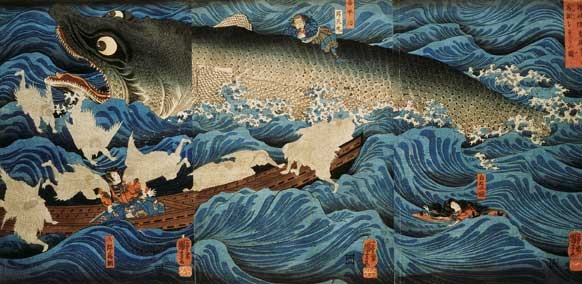It’s customary now to speak of the oddities discovered on remote excursions to the ocean floor as if they were aliens from the outer reaches of the cosmos. All those crepitating spindly creatures, or globular beings hardly distinguishable from their demersal medium, have so matched our extraterrestrial predictions as to sink into our minds like a plumb line the idea that the sea is our century’s scientific frontier. There is something of this deep-space bestiary about Aquatopia – an ambitious transhistorical trawl curated by Alex Farquharson – but this richly stocked and strange show is a reminder too that other fantasies have long exercised the sunken imagination. Chief among them: our figuring the deep as past or potential home.
You can see this tendency in Jules Verne’s 20,000 Leagues Under the Sea (1870) – the Nautilus as floating bourgeois parlour – or in the Victorian craze for aquariums, which in Aquatopia is alluded to by frond-filled stage sets designed by Henry Emden in 1903 and taxonomist Ernst Haeckel’s illustrations of the forms of sea creatures. The underwater films of Jean Painlevé intensified and perverted the nineteenth century’s aquatic gaze; his Love Life of the Octopus (1965) is a late instance of investigations begun during the 1920s, when images from his jauntily soundtracked studies of crustaceans and sea horses appeared in Georges Bataille’s journal Documents. The show includes playful diversions of this genre: Hannah Wilke’s video Hello Boys (1975), in which the artist’s face looms behind aquarium glass, and Alex Bag and Ethan Kramer’s slapstick mock-documentary Le Cruel et Curieux Vie du la Salmonellapod (2000). According to such works, even when they’ve come some satiric distance from the original urge, the deep ocean is a fantastical residence, exotic and ancient: Verne’s ‘perfect Pompeii escaped beneath the waters’.
But fantasised homes have a tendency to turn unheimlich, and a good deal of Aquatopia is consequently given over to monsters that at their most extreme and estranging seem to resemble ourselves: from Hokusai’s Tako to Ama (Pearl Diver and Two Octopi) (1814) to Shimabuku’s collection, in Octopus Stone (2013), of transitional objects found among the coils of inquisitive cephalopods. The most alarming and suggestive property of the deep ocean and its denizens is exactly this tendency to mimicry and mutation, and the two most substantial videoworks in Aquatopia confirm as much. The Otolith Group’s Hydra Decapita (2010) concerns a mythical sci-fi race conjured by the Detroit techno group Drexciya: superpowered amphibians descended from drowned Atlantic slaves. And Mikhail Karikis’s multiscreen SeaWomen (2012) shows octogenarian divers from the North Pacific island of Jeju, whose breathing technique makes them sound like aquatic mammals of another species – our briny twins.
This review was first published in the October 2013 issue.
